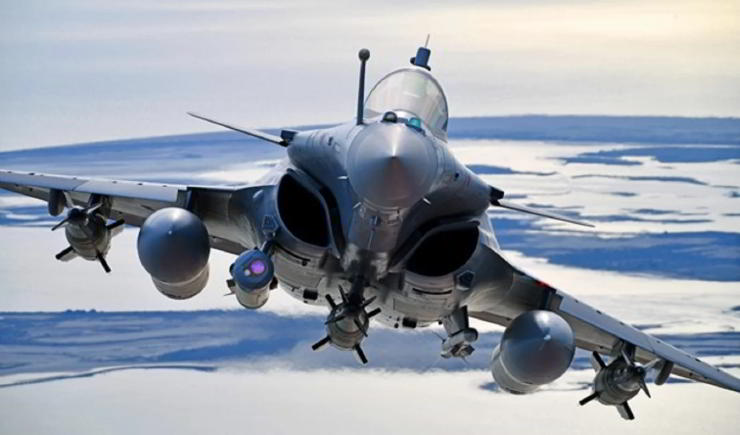According to new data on international arms transfers recently published by the Stockholm International Peace Research Institute (SIPRI), Ukraine has become the world’s largest importer of major weapons in 2020-24, with imports almost 100 times higher than in 2015-19.
European arms import overall grew by 155 per cent between 2020-2024, as states responded to Russia’s invasion of Ukraine and uncertainty over the future of US foreign policy. The United States further increased its share of global arms exports to 43 per cent, while Russia’s exports fell by 64 per cent.
The overall volume of arms transfers globally remained at roughly the same level as in 2015–19 and 2010–14 (but was 18 per cent higher than in 2005–2009), as increasing imports in Europe and the Americas were offset by decreases in other regions.
The top 10 arms exporters in 2020–24 were the same as those in 2015–19 but Russia (accounting for 7.8 per cent of global arms exports) fell to third place behind France (9.6 per cent), while Italy (4.8 per cent) jumped from 10th to sixth place.
At least 35 states sent weapons to Ukraine after Russia’s full-scale invasion in 2022, and substantial further deliveries are in the pipeline. Ukraine received 8.8 per cent of global arms imports in 2020–24.
Most of the major arms supplied to Ukraine came from the USA (45 per cent), followed by Germany (12 per cent) and Poland (11 per cent). Ukraine was the only European state among the top 10 importers in 2020–24, although many other European states significantly increased their arms imports in the period.
European NATO members – According to SIPRI, arms imports by the European NATO members more than doubled between 2015–19 and 2020–24 (+105 per cent). The USA supplied 64 per cent of these arms, a substantially larger share than in 2015–19 (52 per cent). The other main suppliers were France and South Korea (accounting for 6.5 per cent each), Germany (4.7 per cent) and Israel (3.9 per cent).
Arms exports by the USA increased by 21 per cent between 2015–19 and 2020–24, and its share of global arms exports grew from 35 per cent to 43 per cent. The USA supplied major arms to 107 states in 2020–24.
For the first time in two decades, the largest share of US arms exports in 2020–24 went to Europe (35 per cent) rather than the Middle East (33 per cent). Nevertheless, the top single recipient of US arms was Saudi Arabia (12 per cent of US arms exports).
In contrast to the USA, arms exports by Russia fell sharply (–64 per cent) between 2015–19 and 2020–24. The decline started before Russia’s full-scale invasion of Ukraine in February 2022: in 2020 and 2021 export volumes were much smaller than in any year in the previous two decades.
Russia delivered major arms to 33 states in 2020–24. Two thirds of Russian arms exports went to three states: India (38 per cent), China (17 per cent) and Kazakhstan (11 per cent).
France became the world’s second largest arms supplier in 2020–24, delivering arms to 65 states.
France’s exports of major arms to other European states almost trebled between 2015–19 and 2020–24 (+187 per cent). This was mainly due to deliveries of combat aircraft to Greece and Croatia, and arms supplies to Ukraine after Russia’s full-scale invasion in 2022.
Nevertheless, India received by far the largest share of French arms exports (28 per cent)—almost twice the share that went to all European recipients combined (15 per cent). The second largest recipient of major arms from France was Qatar (9.7 per cent of French arms exports).
China was the fourth largest exporter of arms in 2020–24, with 5.9 per cent of global arms exports. Despite China’s efforts to increase its arms exports, many large importers do not buy Chinese arms for political reasons.
Asia and Oceania – The share of global arms transfers going to states in Asia and Oceania fell from 41 per cent to 33 per cent between 2015–19 and 2020–24. A 21 per cent drop in imports to the region was in large part due to arms imports by China shrinking by 64 per cent between the two periods, as it increasingly substituted imports—mainly from Russia—with locally designed and produced weapon systems. China’s arms imports are likely to keep falling as the capacity of its domestic arms industry grows.
Four states in Asia and Oceania ranked among the 10 largest arms importers globally in 2020–24: India, Pakistan, Japan and Australia. China dropped out of the top 10 arms importers for the first time since 1990–94. The main suppliers to the region in 2020–24 were the USA, which accounted for 37 per cent of regional arms imports, Russia (17 per cent) and China (14 per cent).
India was the world’s second largest arms importer, with its imports reflecting perceived threats from both China and Pakistan. However, its imports decreased by 9.3 per cent between 2015–19 and 2020–24. The largest share of Indian arms imports (36 per cent) came from Russia, a significantly smaller share than in 2015–19 (55 per cent) and 2010–14 (72 per cent). Arms imports by Pakistan grew by 61 per cent between 2015–19 and 2020–24. China became even more dominant as its supplier, accounting for 81 per cent of Pakistan’s arms imports in 2020–24, compared with 74 per cent in 2015–19.
With the sharp drop in China’s arms imports, and marked decreases in imports by Taiwan (–27 per cent) and South Korea (–24 per cent), arms imports by East Asian states shrank by 22 per cent between 2015–19 and 2020–24. Japan (+93 per cent) was the only East Asian state that saw an increase in its arms imports.
‘While arms imports to Europe and the Middle East continue to grab media attention, Asia and Oceania remained the largest arms-importing region in the world in 2020–24, as it has been almost invariably since the early 1990s,’ said Siemon Wezeman, Senior Researcher with the SIPRI Arms Transfers Programme. ‘Threat perceptions concerning China are behind much of the arms procurement in the region.’
Middle East – Arms imports by states in the Middle East fell by 20 per cent between 2015–19 and 2020–24. Four of the top 10 global importers in 2020–24 were in the Middle East: Qatar, Saudi Arabia, Egypt and Kuwait. Qatar was the world’s third largest arms importer in 2020–24 (up from 10th largest in 2015–19). Between 2015–19 and 2020–24, Saudi Arabia’s arms imports decreased by 41 per cent.
More than half of arms imports to the Middle East came from the USA (52 per cent), while 13 per cent came from Italy, 9.8 per cent from France and 7.6 per cent from Germany.
Despite the ongoing war in Gaza, arms imports by Israel remained largely stable between 2015–19 and 2020–24. In 2020–24 the USA supplied the biggest share of Israel’s arms imports (66 per cent), followed by Germany (33 per cent) and Italy (1.0 per cent). Israel was the 15th largest arms importer globally in 2020–24, down from 14th in 2015–19.
‘Israel has received substantial military aid from the USA following the Hamas-led attack on 7 October 2023,’ said Zain Hussain. ‘However, for its recent military operations, Israel has employed mainly US-supplied weapons it had received earlier. Israel’s adversaries Hamas, Hezbollah and the Houthis have relied on Iranian arms, and Hezbollah and the Houthis have used Iranian-supplied missiles and drones against Israel.’ (Sipri Media) – (French Air Force/Rafale combat aircraft – Credit: Dassault Aviation)









